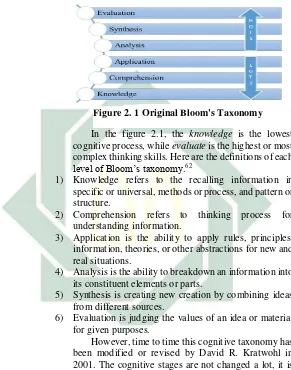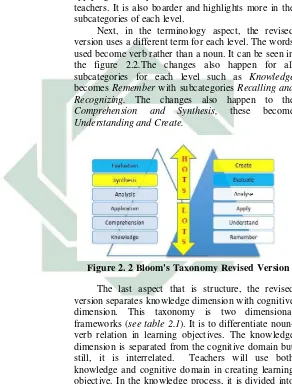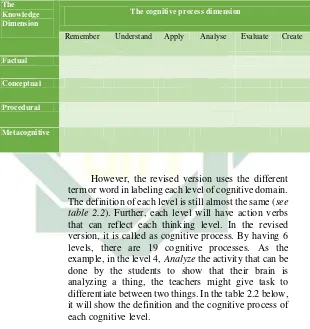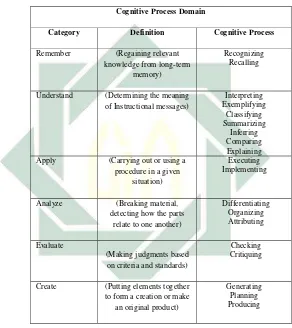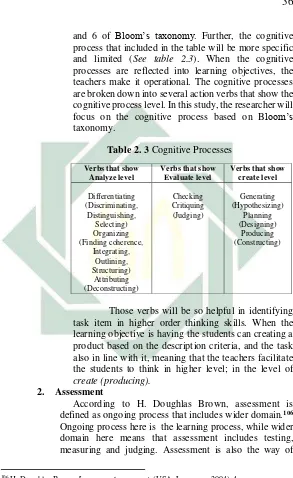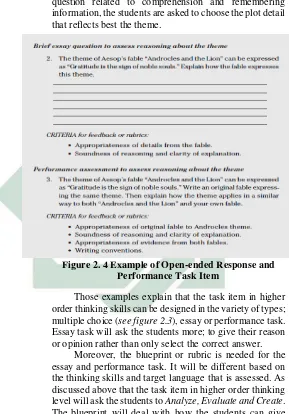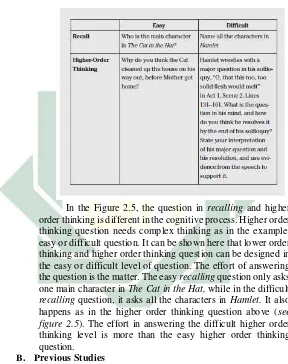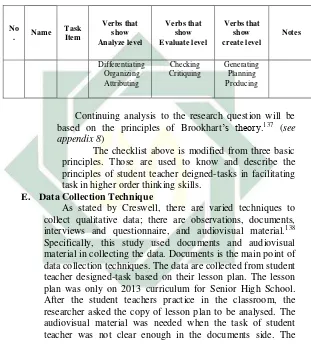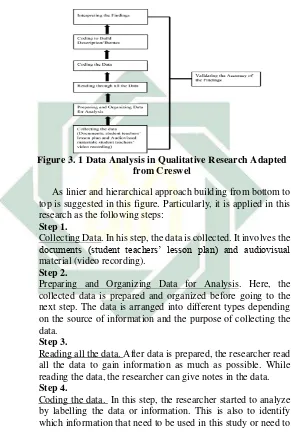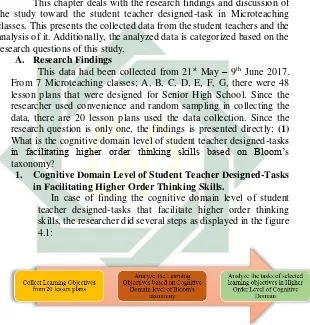ABSTRACT
Salam, Hamidah. (2017). Student Teacher Designed-Tasks in Facilitating
Higher Order Thinking Skills at Microteaching Classes of UIN Sunan Ampel Surabaya. A Thesis. English Teacher Education Department, Faculty of Education and Teacher Training, UIN Sunan Ampel. Advisors: Dra. Irma Soraya, M. Pd.
Key words: Higher Order Thinking Skills, Bloom’s Taxonomy Revised
Version, Task.
Since higher order thinking skills become one of education goals, the thinking skills become essential for teachers in teaching it to
learners. In Bloom’s taxonomy, the cognitive domain, Analyze, Evaluate,
and Create level are defined as higher order thinking skills. In constructing the tasks, there will be several ways used to construct task in higher order thinking level. This study focuses on identifying student teacher designed-tasks in facilitating higher order thinking skills in their Microteaching classes as their preparation before going to internship. This study used qualitative method and checklist as the instrument. In particular, 20 lesson plans were analyzed to identify the tasks designed by the student teachers. In order to support the data, the students were interviewed. Based on the findings and the discussion, the student teacher designed-tasks that can facilitate higher order thinking skills are in the
level 4 and 6 of Bloom’s cognitive domain. In relation to the principles of constructing tasks in higher order thinking skills, those tasks can present
several principles from Brookhart’s such as the task presents resource or
introductory material and the task asks to construct response. As a conclusion, tasks that are designed by the student teacher in UIN Sunan Ampel Surabaya can facilitate higher order thinking skills in the level 4
and 6 of Bloom’s cognitive domain by presenting principles of
ABSTRAK
Salam, Hamidah. (2017). Student Teacher Designed-Tasks in Facilitating
Higher Order Thinking Skills at Microteaching Classes of UIN Sunan Ampel Surabaya. Skripsi. Prodi Pendidikan Bahasa Inggris, Fakultas Tarbiyah dan Keguruan, Univeersitas Islam Negri Surabaya. Pembimbing: Dra. Irma Soraya, M.Pd.
Kata Kunci: Higher Order Thinking Skills, Bloom’s Taxonomy Revised
Version, Task.
Sejak kemampuan berpikir tingkat tinggi menjai salah satu dari tujuan pendidikan, kemampuan berpikir menjadi penting untuk diajarkan oleh para guru kepada peserta didik. Dalam taksonomi Bloom, di ranah kognitif, kemampuan berpikir tingkat tinggi didefinisikan sebagai level
menganalisa, mengevaluasi dan mencipta. Dalam pembuatan tugas atau latihan dalam kemampuan berpikir tingkat tinggi, ada beberapa cara yang bisa digunakan untuk memfasilitasinya. Penelitian in berfokus pada tugas yang dibuat oleh mahasiswa PPL dalam memfasilitasi kemampuan
berpikir tingkat tinggi di kelas Microteaching sebagai persiapan mereka
sebelum melakukan Praktek Pengalaman Lapangan di sekolah. Penelitian ini menggunakan metode kualitatif dimana instrument yang digunakan
adalah checklist. Khususnya, ada 20 Rencana Pelaksanaan Pembelajaran
yang dianalisa untuk mengetahui tugas yang dibuat oleh para mahasiswa PPL Sebagai data penunjang, mahasiswa PPL juga diwawancara. Berdasarkan hasil penemuan dan diskusi, ditemukan bahwa tugas yang dibuat oleh mahasiswa PPL memfasilitasi kemampuan berpikir tingkat tinggi pada level 4 dan 5 dari level pengetahuan taksonomi Bloom. Sehubungan dengan prinsip-prinsip dalam membuat tugas yang menfasilitasi kemampuan berfikir tingkat tinggi, tugas-tugas tersebut bisa menampilkan beberapa prinsip seperti tugas yang menggunakan materi pengantar dan tugas yang meminta siswa untuk memberikan respon. Kesimpulannya, tugas yang dibuat oleh mahasiswa UIN Sunan Ampel Surabaya bisa memfasilitasi kemampuan berfikir tingkat tinggi pada level 4 dan 6 dari pengetahuan level taksonomi Bloom dengan menggunakan
prinsip dari Brookhart’s. Oleh karena itu, hal tersebut bisa sebuah contoh untuk mahasiswa di Jurusan Pendidikan Bahasa Inggris dalam membuat tugas untuk memfasilitasi kemampuan berpikir tingkat tinggi dan sebagai
TABLE OF CONTENTS
COVER ... i
ADVISOR APPROVAL SHEET ... i
EXAMINER APPROVAL SHEET ... ii
PERNYATAAN KEASLIAN TULISAN ... iii
MOTTO... iv
DEDICATION ... v
ACKNOLEDGMENT... vi
ABSTRACT ... ix
TABLE OF CONTENTS ... xi
LIST OF TABLE ... xiv
LIST OF FIGURES ... xv
LIST OF CHART ... xvi
LIST OF APPENDICES ... xvii
CHAPTER I ... 1
INTRODUCTION... 1
A. Research Background ... 1
B. Research Questions... 10
C. Objective of the Study ... 10
D. Significance of the Study ... 10
E. Scope and Limits of The Study ... 11
CHAPTER II... 14
REVIEW OF RELATED LITERATURE ... 14
A. Theoretical Framework ... 14
1. Higher Order Thinking Skills ... 14
a. Definition of Higher Order Thinking Skills ... 15
b. Bloom’s Taxonomy ... 19
2. Assessment ... 36
a. Basic Principles of Constructing Assessment ... 39
b. Principles of Constructing Task in Higher Order Thinking Skills ... 41
B. Previous Studies ... 46
CHAPTER III ... 49
RESEARCH METHOD ... 49
A. Research Design and Approach ... 49
B. Research Setting ... 49
C. Data and Source of the Data... 50
D. Instruments ... 50
E. Data Collection Technique... 52
F. Data Analysis Technique ... 53
G. Checking Validity of Findings ... 55
CHAPTER IV ... 58
RESEARCH FINDING AND DISCUSSION... 58
A. Research Findings ... 58
1. Cognitive Domain Level of Student Teacher Designed-Tasks in Facilitating Higher Order Thinking Skills. ... 58
B. Discussion ... 67
1. Classified Student Teacher Designed-Tasks of Cognitive Domain Level in Facilitating Higher Order Thinking Skills. ... 67
CHAPTER V ... 83
CONCLUSION AND SUGGESTION... 83
A. Conclusion ... 83
B. Suggestion ... 83
REFERENCES ... 85
CHAPTER I INTRODUCTION
This chapter discusses the researcher’s purpose in doing this study. It
starts from the reasons of accomplishing this research. Then, it continues to the research questions and the objectives by conducting this research. Further, significance of the study, scope and limits of the study, and definition of key terms are also presented to give more information dealing with the benefits, the boundary and the term used in this research.
A. Research Background
There are several rules owned by the teachers. One of them is as the knowledge transmitter. If the role of the teacher is to
transmit the knowledge to the learners, the students’ role is to
acquire all the transmitted knowledge. The knowledge that the teachers give is stated in the learning objectives. In the learning objectives, the knowledge and the way how the students get the knowledge are stated. The learning objectives are used as goal that need to be achieved by the students. Here, teachers are questioned about what can the students do or learn after studying a certain material. That question can be answered by knowing the result or the outcome of the students.
To know the learning outcomes of the students, a teacher need to conduct an assessment. This occurs since in education, assessment is an essential
process.1
Assessment can involve testing, measuring, collecting, combining information and providing feedback. Good assessment design will give the teacher clear outcomes to interpret in the form of score or feedback. In assessment for
learning, feedback is needed to improve and develop students’
ability. It means that good assessment will give useful
information about students’ progress.2
That useful information is used to decide whether the learning objective can be continued or repeated.
1 Centre for Educational Research and Innovation. Assessment for Learning; Formative
Assessment.
2
In assessing the students, the teacher may give activities and tasks in order to achieve the learning objectives. What the teachers want the student to learn is learning objective. Assessment also needs to be in line with the learning objective so the learning objective can be judged as success or fail outcomes. As stated by Lee, task is defined as any language learning effort that ask students to master, manipulate, and/or produce the target language as they perform some set of
workplans.3
The aim of giving tasks is to train and help the students in achieving learning objectives. The tasks may be in the form of discussion, presentation or test. Multiple choice and
fill in the blank are the common task item used in the classroom.4
Those items are chosen because they are practical. The practicality can be seen in the way students choose or select one best answer and when the teachers score the students’ result. Other advantages are more reliable and lower anxiety level.5
Another tasks that also used are fill in the blanks, short and long answer, matching, true-false, and descriptive test. Those tasks in 2013 curriculum are called as written test. There are three assessment techniques in 2013 curriculum; written test, oral test,
and assignment.6
Oral test will be in the list of questions and assignment is usually done outside the classroom.
To design good task in assessment, some principles or guidelines are revealed by some experts. H. Doughlas Brown clearly explained that there are five principles for evaluation of classroom tests.7
Those are reliability, practicality, validity, authenticity, and washback. Further, he stated that it will be
complicated to only focus on those five principles.8
Meaning that the five principles from Brown can be added for other principles.
3 Foreign Language Teaching Methods; Speaking. Lesson 3: Designing Communicative
task. (http://www.shanghairanking.com/wcu/wcu1/Tai.pdf , accessed on February 22nd,
2017)
4Foreign Language Teaching Methods; Speaking. Lesson 3: Designing Communicative
task. (http://www.shanghairanking.com/wcu/wcu1/Tai.pdf , accessed on March 13th, 2017) 5 Foreign Language Teaching Methods; Speaking. Lesson 3: Designing Communicative
task. (http://www.shanghairanking.com/wcu/wcu1/Tai.pdf , accessed on March 13th, 2017) 6 Permendikbud Tahun 2016 No. 22
3
However, Susan M.Brookhart has three basic principles in
designing good assessment.9
The principles to construct good assessment is not patent to five or three number, but it depends on situation.10
It can be added or simplified based on the situation; purpose of assessment (summative or formative) and perspective of stakeholders.11
Besides, it is clearly stated in the 2013 curriculum that
the evaluation in the learning process is using authentic
assessment rather than traditional assessment.12
Authentic assessment will help the teachers in gaining much information
related to the students’ improvement. J. Mihael O’ Malley and
Lorraine Valdez Pierce stated that authentic assessment is
multiple types of assessment that can show the students’
learning, accomplishment, motivation and attitudes on
instructionally-relevant classroom activities.13
The authentic assessment will provide the assessment in higher-order thinking
skills as well. It is based on J. Mihael O’ Malley and Lorraine
Valdez Pierce’ explanation that authentic assessment has several characteristics; (1) constructed response, (2) Higher order thinking, (3) Authenticity, (4) Integrative, (5) Process and product, and (6) Depth versus breadth.14
Constructed response here means the tasks are asked students to give response in short and can be expanded for the longer explanation. The response that comes from the tasks that ask the students to think critically and creatively are facilitating higher order thinking skills. When the tasks ask the students to give response in critical or creative way, meaning that the tasks are in higher order thinking. Next, authenticity is about the meaningful and challenging task that close to the real-world. The tasks that can integrate more than
9 Susan M Brookhart. How to Assess Higher-order thinking skills in your classroom.
(United States of America: ASCD Publication, 2010), 17.
10John Norcini. “Criteria for Good Assessment; Consensus and Recommendation from the Ottawa 2010 Conference”. Medical Teacher. Vol.33. 2013, 206
11 Ibid, 206.
12 Permendikbud Tahun 2016 No. 22
13J. Michael O’ Malley - Lorraine Valdez Pierce. Authentic Assessment For English
Language Learners. (California : Longman, 1996) , 4.
14J. Michael O’ Malley - Lorraine Valdez Pierce. Authentic Assessment For English
4
one language skills is integrative task. Further, process and product means in the process of creating a product is also important and need to be assessed. It is because in the process of creating, the students are exploring more than one solutions and more than one mental or cognitive activities. As the last characteristic, depth versus breadth provides depth information
about the students’ skills. By providing an assessment that includes all of authentic assessment characteristics, the students can be facilitated in completing complex task by using previous
knowledge and relevant skills to solve real problems.15
Furthermore, becoming one of the characteristics of authentic assessment, higher order thinking skills train the students to think more complex in facing problem in the real world. Asking the students to think more complex means requiring them to think critically and creatively and solve
problem.16
For instance, in studying English, the students are provided a paragraph of problem about a hot topic or issue recently. If it goes to higher order thinking skills, the possible
learning objective today will be students will be able to produce
the best solution towards the problem.17 This task will facilitate the students to think in more complex, creative and critic way. The task in the format open-ended question will be better rather than multiple choice because the students can provide their solution and support it with their argument. By asking the students to produce the best solution, the teachers facilitate the students the thinking skills of hypothesizing; cognitive process of create. This thinking skills allow the students to have more
than one right answer.18
If higher order thinking skills refer to the teachers’ learning objective, it will connect to cognitive process domain of learners. To assess cognitive domain of the students, teachers are helped by the framework of cognitive domain. One of
15 Ibid, 5.
16 Nur Rochmah Laily - Asih Widi Wisudawati. “Analisis Soal Tipe Higher Order Thinking Skill (HOTS) Dalam Soal UN Kimia Rayon B Tahun 2012/2013”. Kaunia. Vol.11 No.1, April 2015. 28
17 L. W. Anderson, et.al., A Taxonomy For Learning, Teaching And Assessing. (New York:
Longman, 2001), 86.
5
cognitive domain frameworks is Bloom’s taxonomy. Instead of
using SOLO taxonomy, Webb’s taxonomy or Marzarano taxonomy, Bloom’s taxonomy is believed as the concise and
clear taxonomy in specifying the cognitive level.19 As in
Bloom’s taxonomy revised version remember, understand, and
apply as level number one, two, and three show the lower level of thinking skills, while analyse, evaluate and create as level number four, five and six show the higher level of thinking skills.
Bloom’s taxonomy helps the teachers in categorizing learning
objectives and assessments according to the level of
complexity.20
As the example before that stated students will be
able to produce the best solution towards the problem is in the level of create. This level is the highest level in Bloom’s
taxonomy revised version. This learning objective asks the teacher to provide the students a task in higher order thinking skills.If the teachers cannot provide task in higher order thinking skills, it is automatically said that the teacher cannot fulfil one of the characteristic of authentic assessment.
It will be a big question for the teachers about how they design the assessment task. Do the teachers correctly design the assessment following the principle of good assessment? Are the tasks in the complexity level or difficulty level? Do the tasks facilitate higher order thinking skills? Why higher-order thinking skill become important is that because the goal of education itself is preparing the students to identify and solve problems in the real world.21
The problems will come either from academic work or problem of life.
Using higher-order thinking skills, students are expected to solve the problem by identifying and critiquing the best solution and think creatively to keep safe. This, additionally,
becomes becomes the teachers’ job to facilitate task in higher
order thinking skills for the students which asks the students to think not only in the difficulty but also in the complexity. When the teachers can provide tasks correctly by following the
19 Anat Zohar. Higher Order Thinking in Science Classrooms: Students’ Learning and
Teachers’ Professional Development. (Springer Science + Business Media B.V, 2004), 1.
20 Susan M Brookhart. How to Assess Higher-order thinking skills in your classroom.
(United States of America: ASCD Publication, 2010), 39.
6
principles and facilitate higher order thinking skills as well, automatically they help the students to earn good outcomes and train them to think in higher order level. Also, it is a reflection of the authentic assessment in 13 curriculum.
However, we cannot deny that teachers’ ability in
facilitating higher order thinking skills will be reflected upon the
teachers’ competence.22
The problem may come from the teachers that only provide the task in lower order thinking skills. Whereas, the activity in the learning process already facilitate higher order thinking skills. Another possibilities is that the task is only in the level of difficulty not in the level of complexity. These two terms are different. The task in the lower or higher order thinking skills can be in easy or difficult task level. Easy task is not always the same as lower order thinking skills task. Difficulty here refers to the effort on doing the task, while complexity refers to the kind of thinking used to answer the task.23 The more difficult the task is, the more effort is needed. Whereas, the more complex the task, the more cognitive skill is used to do the task. Those problems also happened to the student teachers in this English Teacher Education Department of UIN
Sunan Ampel Surabaya.As the preliminary research data, there
are only 5 lesson plans from 10 randomly chosen lesson plans that provide task in higher order thinking skills in academic year 2015/2016. The task by the students teachers is analysed using
Bloom’s taxonomy to know whether their task facilitate higher
order thinking skills or not. From those 5 lesson plans, all of the
tasks are in the create level; ask the students to make, produce
or do role-play. However, those tasks need further analysis to meet the criteria of constructing task in higher order thinking skills.
Based on the preliminary research phenomena, this study focuses on identifying the student teacher designed-task in facilitating higher-order thinking skills. As the importance of higher order thinking skills in education, the student teachers also need to be trained in providing task that can facilitate higher
22 Ramdhan Witarsa - Yuli Nurul Fauziah. “Kemampuan Guru Dalam Mengembangkan Keterampilan Berpikir Kreatif Pada Pembelajaran Sains SD”. Pendidikan Sains. DP. Jilid 11, Bil.2/2011.
7
order thinking skills. This is also in line with two of three goals of English Teacher Education Department in UIN Sunan Ampel
Surabaya that stated “Creating professional, innovative and
pious English teacher graduates” and “Creating creative and innovative contribution and development product of English Teacher Educastion Department”.24
Being creative teacher may help the students by facilitating the activity and task in higher order thinking skills. As stated by Guilford, there are five characteristics of creative thinking; fluency, elaboration, flexibility, originality and redefinition.25 In further discussion, fluency here means the ability to create and produce ideas. By having ability in creating new idea, the teachers will trained to think in higher order thinking as well.
In designing the task in higher order thinking skills, the task will be limited to the written test provided by the subject of this study. This is chosen by considering what the student teacher can do in their teaching practice in twenty minutes. The subject
of this study is the 6th semester students who take Microteaching
class or PPL 1. This class is conducted in the faculty that made
their own friend become the students. Commonly,
Microteaching class contains of 12 student teachers. Microteaching class become important in order to prepare the student teachers in real teaching practice; PPL 2. In this Microteaching class, the student teachers are asked to prepare the lesson plan and have short teaching performance for about
20 to 30 minutes.26
This study chose student teachers of Islamic State University of Sunan Ampel as the subject because this university is in ongoing process to be the World Class University after upgrading from Islamic State Institute since 2013. To be confirmed as the World Class University, there are three aspects that play as important factors. They are (a) a high concentration
24 Pendidikan Bahasa Inggris. ”Tentang PBI”. (http://pbisa.wordpress.com/about/ ,
accessed on February 22nd, 2017 )
25 Ramdhan Witarsa - Yuli Nurul Fauziah. “Kemampuan Guru Dalam Mengembangkan Keterampilan Berpikir Kreatif Pada Pembelajaran Sains SD”. Pendidikan Sains. DP. Jilid 11, Bil.2/2011.
26 IAIN Sunan Ampel Surabaya. Panduan Penyelenggaraan Pendidikan Strata Satu (S1)
8
of talent (faculty and students), (b) abundant resources and (c)
favourable governance features.27
So, to be World Class University, State Islamic University of Sunan Ampel needs to develop those criteria to compete in the global field.
In the aspect of a high concentration of talent focuses on the attendance of a critical mass of top students and well-known faculty.28
It means that to achieve this aspect, the qualified professors, lecturers, stuffs and selected students play important role to build high quality faculty. The selected students are expected to do their best research and be outstanding outcomes from the faculty. To attract the most talented people in one of majors, the faculty needs to show their best outcomes to the public. This can be an evidence to attract people from many places.
To become the World Class University, Islamic State
University of Sunan Ampel Surabaya also needs to show the evidence to the public. One of favourite faculties in Islamic State University of Sunan Ampel based on the enrolment, the Education And Teacher Training Faculty have to proof to public that the teacher outcomes are really qualified as the teacher candidate in the schools. In line with this issue, the English Teacher Education Department who benefits by the language they focus on, can be one of the factors to attract international students to study in the UIN Sunan Ampel Surabaya. As the research of Hsiou-Hsia Tai, the number of international students
also help as the aspect of World Class University.29
Related to this research that focuses in assessment of higher order thinking skills, three studies are stated here as the previous studies. The first study is C.C Chinedu, Y. Kamin and
Olabiyi O.S under the title Strategies for improving Higher
Order Thinking Skills in Teaching and Learning of Design and Technology Education. Here, it shows that the use of concept, interferences, visualization, and scheme can be good strategy to
27 Jamil Salmi. The Challenge of Establishing World-Class Universities. (Washington, DC:
The world bank, 2009), 7.
28 Ibid, 20.
29 Hsiou-Hsia Tai. The Features of World-Class Universities. (Taiwan: National Chiao
9
improve their higher-order thinking skills.30
This study focused on the strategy used by the teachers for improving higher-order thinking skills of students in Design and Technology Education.
The second study comes from Yee Mei Heong, Widad Binti Othman, Jailani Bin Md Yunos, Tee Tze Kiong, Razali Bin
Hassan, and Mimi Mohaffyza Binti Mohamad “The Level of
Marzano Higher Order Thinking Skills among Technical
Education Students”. Yee Mei Heong and friends focus on the level of higher order thinking based on Marzano theory instead of using Bloom theory. This study is quantitative as the questionnaire used as the data collection method. Marzano identifies 13 kinds of higher order thinking skills; comparing, classifying, inducing, deducing, error analysis, constructing supporting, analyzing perspectives, abtracting, decision making, investigation, problem solving, experimental inquiry, and invention.31
Further, the finding shows that the sample of the technical students have moderate level for 7 kinds of higher order thinking skills, and 6 others are in low level of higher order thinking skills.
As the last study, Nur Rochmah Laily and Asih Widi Wisudawati from Islamic State University of Sunan Kalijaga
Yogyakarta conducted “Analisis Soal Tipe Higher Order
Thinking Skill (HOTS) Dalam Soal UN Kimia Rayon B Tahun
2012/2013”. This study uses non-test and Focus Group Discussion (FGD) technique. The result of this study the characteristic of National Examination question in multiple choices is stimulus which the skills of critical and creative
thinking still cannot be concluded.32
In sum, this study is conducted to make differences from the previous studies. This study focuses on analyzing the task
30C.C Chinedu, et.al, “Strategies for improving Higher Order Thinking Skills in Teaching
and Learning of Design and Technology Education”. Journal of Technical and Training. Vol.7 No. 2. December 2015, 35.
31 Yee Mei Heong, et.al.,“The Level of Marzano Higher Order Thinking Skills among
Technical Education Students”. International Journal of Social Science and Humanity. Vol. 1, No. 2, July 2011. 121.
10
that is designed by the student teachers whether they can facilitate higher order thinking skills or not. In analyzing higher
order thinking skills, Bloom’s taxonomy revised version in 2001
is used in this study as the main theory. Additionally, it also continued on the principles used in constructing task in
facilitating higher order thinking skills based on the Brookhart’s
theory.
B. Research Questions
In relation to the background of the study previously outlined above, the problem of the study can be formulated as this following question:
What is the cognitive domain level of student teacher designed-tasks in facilitating higher order thinking skills
based on Bloom’s taxonomy? C. Objective of the Study
This research is aimed to find out:
To describe the level of cognitive domain level of student teacher designed-tasks in facilitating higher order thinking skills.
D. Significance of the Study
This result of the study is expected to give contribution for both teachers and the learners. In particular, this study can increase the awareness of the teachers and the students about how assessment in higher order thinking skills is expected.
For the student teachers, this study will increase their awareness of higher order thinking skills in designing task that is expected in 2013 curriculum. It will help them understand more about assessment of higher-order thinking that dealing with critical thinking, problem solving and creative thinking. This study also provide guidelines based on Susan M. Brookhart theory in constructing task in higher order thinking skills. After knowing it, the student teachers can be guided by this study in enhancing the knowledge and their ability in designing the task.
11
Furthermore, this study can help the faculty to enhance
the student teachers’ quality in teaching before having the real teaching practice or PPL 2.
E. Scope and Limits of The Study
The scope of this study is the tasks that are designed by student teachers in their Microteaching class. The curriculum used in designing lesson plan is 13 curriculum that is specifically designed for Senior High School students. It is because Senior High School students are believed to have more background knowledge and developed cognitive skills rather than Junior High School students. K13 curriculum has four aspects; theology aspect, attitude aspect, knowledge aspect and skill aspect. Further, in assessing knowledge aspect, the techniques can be used are written test, oral test and assessment. Besides the knowledge aspect only, written test in reading and writing skills also become the focus of this study. It is because of the most possible test that can be done by the student teachers. In analysing the data, the theory of Bloom will be used
as the main theory. In the theory of Bloom’s taxonomy, higher
order thinking skills will be in the level number 4, 5, and 6. In
relation to the Bloom’s taxonomy, the principles theory in
constructing task in higher order thinking skills of Brookhart’s
will be used as well as the deeper analysis.
The limits of this study is student teachers in Microteaching class of State Islamic University of Sunan Ampel Surabaya in academic year 2017/2018. From nine classes provided with four different lecturer, the researcher will collect the data for only seven classes since the rest two classes do not use specific curriculum in designing the lesson plan.
F. Definition of Key Terms
In order to have the same idea and concept in this study, the researcher clarifies the terms used in this study, as the details are:
12
Susan M. Brookhart explained that Higher-order thinking skills defined into three categories; (1) transfer, (2) critical, and (3) problem solving.33
In this study, higher order thinking skills is defined as the complex way of thinking as include critical thinking, creative thinking, and problem solving.
2. Bloom’s Taxonomy
Bloom’s taxonomy is a framework for categorizing
educational objectives.34
In this study, Bloom’s taxonomy defines as the
category level of cognitive process in constructing the learning objective and assessment. The revised version of
Bloom’s taxonomy has six level; remember, understand,
apply, analyze, evaluate and create. The last three level reflect the level of higher order thinking skills.
3. Assessment
Assessment is a systematic process of gathering information about what a student knows, is able to do, and is learning to do.35
In this study, assessment is defined as the way how the
teacher collecting the data about the students’ knowledge.
The assessment can include measuring, judging, and testing.
4. Task
Task is a specific test item, topic, problem, question,
prompt, or assignment.36
As defined in this study, task is the teacher’ effort to
gain the students’ knowledge. It will be in the form of
exercises or test, such as question, test item, and prompt.
5. Student Teacher Designed-Tasks
33 Susan M Brookhart. How to Assess Higher-order thinking skills in your classroom.
(United States of America: ASCD Publication, 2010), 3.
34 L. W. Anderson, et.al., A Taxonomy For Learning, Teaching And Assessing. (New York:
Longman, 2001), 4.
35 Senior 1 to Senior 4 Spanish Language and Culture; Classroom Assessment. 3. 36 Mary J. Pitoniak, et.al., . Guidelines for the Assessment of English Language Learners.
13
In Cambridge dictionary, design is to make or draw plans for something.37
In this study, student teacher designed-tasks are tasks that are made and provided by the student teacher to assess the learning objectives. The tasks can be originally made or adapted with some modification by the student teachers.
6. Principles of Constructing Tasks
In Oxford dictionary, principle is an essential source or
basis of something.38
Principles of constructing tasks here means some basises in constructing or designing tasks.
7. Microteaching
Teaching practice or PPL 1 done by 6th semester student
of English Teacher Education Department with 20 minutes duration and the friends act as the students.
8. Student Teacher
Student Teacher is 6th semester of English Education Department students who take and join microteaching class.
37 Cambridge Dictionary. (https://dictionary.cambridge.org/dictionary/english/design,
accessed on 27th February, 2017)
38 Oxford Dictionary. (https://en.oxforddictionaries.com/definition/principle, accessed on
CHAPTER II
REVIEW OF RELATED LITERATURE
This chapter gives a brief explaination about theories that support this study. There are two sub-section in this chapter, the review of related literature and the previous studies regarding with the analysis of student teacher designed-tasks in facilitating higher order thinking skills.
A. Theoretical Framework
1. Higher Order Thinking Skills
Teachers are demanded to transfer the knowledge or competence to students. However, competence is not the
only thing to teach. The students’ way of thinking is also
important to teach; how the students can get the knowledge. As a broad definition, it is correct that thinking is defined as a mental activity.39 It is because mental activity covers many things. Mental activity in the brain that people cannot see as like physical activity. Mental activity or performance here can be remembering or recalling the fact, reasoning, decision making and solving a problem. Further, Edward De Bono stated that thinking is also defined as logic and reason.40 It deals with the activity of thinking to give a logic reason. Then, thinking skill is defined as the ability in
transforming the knowledge and generating new ideas.41 It
is the way how people explore and apply the idea to the new situation. It is also dealing with the way how people solve the problem by deciding the best solution for the problem. Further, it relates to people’s creativity.
Realizing or not, people may think without thinking. It happened when people are asked about their name or what they like to drink; tea or coffee. People can easily answer it without much thinking skills. However, one of education
39 Edward de Bono. Teaching Thinking. (USA: Penguin Books, 1976), 33. 40 Ibid, 33.
41 C. J. Simister. How to Teach Thinking and Learning Skills. (London: Paul Chapman
15
goal is to prepare students living in the real life. After graduating from school, students do not only deal with the problems that they are familiar with, but also deal with the unfamiliar problems that need a solution. To be successful in life, prioritizing, decision making, strategizing and collaborative problem solving is needed.42 Moreover, the problem of life is more complicated because it deals not only with the book or formula but also with the society, law and tradition. Thus, it needs more than remembering all good solution from books or only understanding the problem, but it needs a creative solution that has been analyzed and reformulated. In the school, when the teachers only teach the knowledge, students cannot deal with a complicated problem. To solve a problem, decision and action are needed. Students need to use the knowledge and apply it that is helped by their good thinking skills.43 Knowledge or information is used as the basic thing to think.44 The more complicated is the matter, the way of thinking is higher. The thinking activities that are believed represent higher order thinking s kills are analysis, evaluation, problem solving and decision making. By teaching thinking skills, students are expected to be a good decision maker and problem solver. Higher order thinking skills need to be taught to students in order to enhance the quality of education.
After reviewing a little bit about the importance of higher order thinking skills, here is more discussion about what higher order thinking skills is.
a. Definition of Higher Order Thinking Skills
As the educational goal, higher order thinking skills need to be introduced to the students in order to prepare them facing the real problem. Many experts defined higher order thinking skills in many kinds of definitions. Krulik and Rudnick stated that there is four
42Bhawani Prasad Mainali. “Higher Order Thinking In Education”. Academic Voices; A
Multipedisciplinary Journal. Vol. 2 No. 1, 2012, 5.
16
level of thinking in general; recall thinking, basic
thinking, critical thinking and creative thinking.45 The
thinking level that considered as higher order thinking skills are critical and creative thinking. FJ King, Ludwika Goodson and Farank Rohani, stated that higher order thinking skills include critical, logical,
reflective, metacognitive and creative thinking.46
In the
journal “Strategies for Improving Higher Order
Thinking Skills in Teaching And Learning Of Design And Technology Education” by C.C Chinedu added that analyzing information to distinguish the problem, evaluating the problem and creating new practical
solution are involved as higher order thinking skills.47
As the conclusion and simply define, higher order thinking skills are complex thinking skills; the thinking skills that use complex or multiple thinking activities. Further, the activity such as analysis, evaluate, decide a solution, solve a problem and be creative are the example of complex thinking skills. Those thinking activities use more than one thinking activity. Additionally, higher order thinking skills also showed
in Bloom’s taxonomy in the 4, 5 and 6 level. Those are Analyze, Evaluate, and Create.
According to Susan M. Brookhart that defined higher order thinking skill in the simple definition, higher order thinking skills include (1) transfer, (2) critical thinking and (3) problem solving.48
It will be defined one by one in the following discussion;
1) Higher Order Thinking Skill as Transfer.
45 Weindy Pramita Ariandari. Mengintegrasikan Higher Order Thinking dalam
Pembelajaran Creative Problem Solving. SEMINAR NASIONAL MATEMATIKA DAN PENDIDIKAN MATEMATIKA UNY 2015, 491.
46 FJ King, Ludwika Goodson - Farank Rohani. Higher Order Thinking Skills; Definition,
Teaching Strategies, Assessment. 1
47 Chinedu, C.C, et.al., “Strategies For Improving Higher Order Thinking Skills In Teaching And Learning Of Design And Technology Education”. Vol. 7, No.2| December 2015| ISSN 2229-8932 Journal of Technical Education and Training (JTET) |36
48 Susan M Brookhart. How to Assess Higher-order thinking skills in your classroom.
17
Susan M Brookhart, take a conclusion from Anderson and Krathwohl in 2001 that learning for transfer is meaningful learning.49
It is defined as learning that will be applied for students. Applied here means the students can use, transfer and explore the knowledge they got to the new situation. The condition that the students can relate their previous experience of learning to the new problem is meaningful learning.
2) Higher Order Thinking Skills as Critical Thinking.
Critical is taken from the ancient Greek word,
Kritikos with meaning able to judge.J Butterworth
added that even critical thinking is as judgment, it
still needs basis called the knowledge.50 In making
a judgment, people do not only judge the thing but also need to know the basic knowledge of their judgment and provide the supporting reason.
Cited in the book How to Assess Higher
Order Thinking Skills in Your Classroom, Norris
and Ennis defined critical thinking as “reasonable,
reflective thinking that is focused on deciding what
to believe or do”. In critical thinking, students are asked to think more detail and critic to be wiser in
deciding a thing. In Critical Thinking Skills
Development book, Stella Cottrell stated that critical thinking is a wide range of skills and attitudes in a complex process of consideration.51 Specifically, Joe Y. F Lau explained that critical
thinking can be seen by doing the following52 ;
(1) Identify, construct, and evaluate arguments.
(2) Formulate ideas succinctly and precisely.
(3) Analyse problems systematically.
49 Ibid, 5.
50 John Butterworth and Geoff Thwaites. Thinking Skills; Critical Thinking and Problem
Solving. Second Edition. (Cambridge: Cambridge University Press, 2013), 7.
51 Stella Cottrell. Critical Thinking Skills Development. (PALGRAVE MACMILLAN,
2005), 2.
18
(4) Identify the relevance and importance of
ideas.
(5) Understand the logical connections between
ideas.
(6) Evaluate the pros and cons of a decision.
(7) Evaluate the evidence for and against a
hypothesis.
(8) Detect inconsistencies and common
mistakes in reasoning.
(9) Justify one's beliefs and values.
(10) Reflect and evaluate one's thinking skills.
In sum, critical thinking is reflected by several thinking activities such as analyzing a problem, evaluating and reformulate the best solution and constructing an argument to support it. By teaching the critical thinking, students are expected to be able to give a logic reason, be reflective and be wiser judgment.
3) Higher Order Thinking as Problem Solving
A problem mostly defined as something that causes difficulty for people. In Oxford dictionary, problem defines as an unpleasant situation that
needs to be overcome.53 To deal with the problem,
people need to have a solution. Be a good problem solver need to think in higher order level. Problem solving is known as the process of thinking that
involves “a series of successive decisions, each of
which depends on the outcomes of those that precede it”.54 Further, cited in the book How to
Assess Higher Order Thinking Skills in Your Classroom, Bransford and Stein classified problem solving skills into five stage process.55 The five stages are called as IDEAL; identify the problem,
53 Oxford Dictionary, (https://en.oxforddictionaries.com/definition/problem , accessed on
24th May, 2017)
54 FJ King, Ludwika Goodson - Farank Rohani. Higher Order Thinking Skills; Definition,
Teaching Strategies, Assessment. 16.
55 Susan M Brookhart. How to Assess Higher-order thinking skills in your classroom.
19
Define and represent the problem, Explore possible strategies, Act on the strategies and Look back and evaluate the effects of the activities.56 By having the problem solving activity, students are expected to solve their problem to construct the best solution for themselves. Those IDEAL steps should be introduced to the students as one of the ways in facilitating higher order thinking skills.
b. Bloom’s Taxonomy
As discussed above that Bloom’s taxonomy also related to higher order thinking skills. In Bloom’s
taxonomy, teachers are helped by the classified cognitive domain to facilitate activity or assessment in
higher order thinking level. Analyze, Evaluate and
Create are cognitive domain level by Bloom that can perform higher order thinking level.
Before discussing more about Bloom’s taxonomy,
there are other cognitive taxonomies in education such
as Marzano and Webb’s Depth of Knowledge . Those
taxonomies also categorize the cognitive process in several levels that are similar to Bloom but different in the term. Marzarano categorized cognitive process into four levels; 1) Retrieval, 2) Comprehension, 3)
Analysis and 4) Knowledge Utilization. Then, Webb’s
DOK also classify cognitive process into four levels; 1) Recall and Reproduction, 2) Skill and Concept, 3) Strategic Thinking and 4) Extended Thinking. These frameworks or taxonomies (Bloom, Marzarano, and
Webb’s DOK) even have different name of each level, they have something in common. Those three taxonomy classified cognitive process from the simple
to the complex thinking process. Further, Bloom’s
taxonomy is widely used in United State of America, while in Australia, New Zealand, Canada, and the
United Kingdom used the SOLO taxonomy.57
56 Ibid, 99.
57 Susan M Brookhart. How to Assess Higher-order thinking skills in your classroom.
20
Furthermore, this research will only focus on
Bloom’s taxonomy that has been revised in 2001 by Lorin W. Anderson and David R. Kratwohl. The reason
is that because Bloom’s taxonomy is classified
specifically. The six levels with 19 cognitive processes helped the educators to decide learning objective and
assessment better in the learners’ perspective.
Additionally, the knowledge dimension and the cognitive process domain are categorized separately, so it is very useful for the teacher to construct learning
objective. It is also stated by Anat Zohar that Bloom’s
taxonomy is categorized and specified the cognitive
process in clear and succinct framework.58
Further, the student teachers in State Islamic University of Sunan
Ampel Surabaya are introduced to Bloom’s taxonomy
rather than the other two taxonomies.
Benjamin Bloom is the one who has a theory about the cognitive domain for categorizing a level of abstraction of questions that commonly occur in educational settings.59
According to A Revision of
Bloom’s Taxonomy; An Overview, David R. Krathwohl
said that the taxonomy of educational objectives is a framework for classifying statements of what we expect or intend to the students to learn as a result of instruction.60
This concept of cognitive domain is released in 1956. The taxonomy is popular under the
name Bloom’s Taxonomy. Then, in 2001, Bloom’s
taxonomy is revised by David R. Krathwohl that has several changes that will be discussed later.
Furthermore, Bloom hoped by this idea, this could serve as a means for determining the compatibility of educational objectives, activities, and assessments in a
58 Anat Zohar. Higher Order Thinking in Science Classrooms: Students’ Learning and
Teachers’ Professional Development. (Springer Science + Business Media B.V, 2004), 1.
59 L. W. Anderson, et.al., A Taxonomy For Learning, Teaching And Assessing. (New York:
Longman, 2001).
60 David R. Krathwohl. “Revising Bloom’s Taxonomy”. Theory Into Practice. (Autumn,
21
unit, course or curriculum.61
Teachers usually use
Bloom’s taxonomy as the guideline in deciding
learning objective and assessment in their lesson plan.
Bloom’s taxonomy is categorized from the simple
thinking skills to the complex one. Before knowing further about the revised version, here is the original
Bloom’s taxonomy in the next figure 2.1.
22
In the figure 2.1, the knowledge is the lowest
cognitive process, while evaluate is the highest or most
complex thinking skills. Here are the definitions of each
level of Bloom’s taxonomy.62
1) Knowledge refers to the recalling information in
specific or universal, methods or process, and pattern or structure.
2) Comprehension refers to thinking process for
understanding information.
3) Application is the ability to apply rules, principles, information, theories, or other abstractions for new and real situations.
4) Analysis is the ability to breakdown an information into
its constituent elements or parts.
5) Synthesis is creating new creation by combining ideas
from different sources.
6) Evaluation is judging the values of an idea or material
for given purposes.
However, time to time this cognitive taxonomy has been modified or revised by David R. Kratwohl in 2001. The cognitive stages are not changed a lot, it is still similar to the original one. The changes are in the three aspects as explained by Anderson and Kratwohl;
62 L. W. Anderson, et.al., A Taxonomy For Learning, Teaching And Assessing. (New York:
[image:32.420.70.361.74.444.2]Longman, 2001), 313-319.
23
in the emphasis, terminology and structure.63 In the emphasis aspect, the revised version focuses more in applying taxonomy for curriculum and its useful for the teachers. It is also boarder and highlights more in the subcategories of each level.
Next, in the terminology aspect, the revised version uses a different term for each level. The words used become verb rather than a noun. It can be seen in
the figure 2.2.The changes also happen for all
subcategories for each level such as Knowledge
becomes Remember with subcategories Recalling and
Recognizing. The changes also happen to the
Comprehension and Synthesis, these become
[image:33.420.69.361.104.488.2]Understanding and Create.
Figure 2. 2Bloom's Taxonomy Revised Version
The last aspect that is structure, the revised version separates knowledge dimension with cognitive dimension. This taxonomy is two dimensional
frameworks (see table 2.1). It is to differentiate
noun-verb relation in learning objectives. The knowledge dimension is separated from the cognitive domain but still, it is interrelated. Teachers will use both knowledge and cognitive domain in creating learning objective. In the knowledge process, it is divided into
63 L. W. Anderson, et.al., A Taxonomy For Learning, Teaching And Assessing. (New York:
24
four dimensions; factual, conceptual, procedural and
metacognitive. Also, the level number 5
(Synthesis/Create) and 6 (Evaluation/Evaluate) are interchanged in the order (see figure 2.2).
Table 2. 1 Knowledge and Cognitive Process Dimension
However, the revised version uses the different term or word in labeling each level of cognitive domain. The definition of each level is still almost the same (see table 2.2). Further, each level will have action verbs that can reflect each thinking level. In the revised version, it is called as cognitive process. By having 6 levels, there are 19 cognitive processes. As the example, in the level 4, Analyze the activity that can be done by the students to show that their brain is analyzing a thing, the teachers might give task to differentiate between two things. In the table 2.2 below, it will show the definition and the cognitive process of each cognitive level.
The Knowledge Dimension
The cognitive process dimension
Remember Understand Apply Analyse Evaluate Create
Factual
Conceptual
Procedural
[image:34.420.75.385.143.472.2]25
This is the revised of Bloom’s Taxonomy based on
Anderson and Kratwohl;64
[image:35.420.72.364.120.448.2]
Table 2. 2 Bloom's Taxonomy Revised Version
Cognitive Process Domain
Category Definition Cognitive Process
Remember (Regaining relevant knowledge from long-term
memory)
Recognizing Recalling
Understand (Determining the meaning of Instructional messages)
Interpreting Exemplifying
Classifying Summarizing
Inferring Comparing Explaining Apply (Carrying out or using a
procedure in a given situation)
Executing Implementing
Analyze (Breaking material, detecting how the parts
relate to one another)
Differentiating Organizing Attributing
Evaluate
(Making judgments based on criteria and standards)
Checking Critiquing
Create (Putting elements together to form a creation or make
an original product)
Generating Planning Producing
64 L. W. Anderson, et.al., A Taxonomy For Learning, Teaching And Assessing. (New York:
26
Further, each cognitive process will be discussed more below.
1. Remember
In this level, the students are asked to retrieve the knowledge from their long term memory. The learning objective is to promote their retention for the new presented material with what they have taught.65 For example, students are given the introduced task just to recall or recognize the same
material that was taught. Recalling and Recognizing is included
as the cognitive processes in this level. In the meaningful
learning and problem solving, remembering knowledge is an
important thing.66As the basic thing to think about, it is the
knowledge.67
Recognizing
Recognizing involves retrieving knowledge from long term
memory in order to compare it with presented information.68 In
this cognitive process, students are asked to match or identify the new presented information with their previous knowledge.
Identifying is the alternative term for Recognizing. In the assessment format, matching task, verification or mostly common example is true-false and multiple choice can be done in this cognitive process. The learning objective is that the students are able to recognize of a material.
Recalling
Recalling is retrieving relevant knowledge from long term
memory when given a prompt to do so.69 The prompt is mostly
a question. As an example, “What is the generic structure of narrative text?” is a prompt that given to make students Recalling their long term memory. Retrieving is the alternative
term for Recalling. In the assessment format, teachers can give
65 Ibid, 66.
66 L. W. Anderson, et.al., A Taxonomy For Learning, Teaching And Assessing. (New York:
Longman, 2001), 66.
67 Edward de Bono. Teaching Thinking. (USA: Penguin Books, 1976), 33.
68 L. W. Anderson, et.al., A Taxonomy For Learning, Teaching And Assessing. (New York:
Longman, 2001), 69.
27
little or more hints to the students. The example before is a question with no hints. The question with several hints are like
this “In narrative text, ____________, _____________, and
____________ are the generic structure of it.”
2. Understand
This level of cognitive domain is higher than
Remembering. When the students already can remember the
knowledge, then the students are expected to “transfer” or “relate” it to the new presented material. Understand is when the students are able to construct meaning from instructional
messages, including oral, written and graphic communication.70
Instructional messages here can be in time during lecturing, in computers or books.71 In this level, cognitive processes that
include as Understand are interpreting, exemplifying,
classifying, summarizing, inferring, comparing, and explaining. Interpreting
This cognitive process happens when the students are able to
change information from one representational form to another.72
Interpreting may involve converting or changing words to words (paraphrasing), picture to words, words to pictures, numbers to words, words to numbers, musical notes to tones, and etc. This will depend on the subject field of the students. The alternative terms for this are translating, paraphrasing, representing, and clarifying. In assessment format, Interpreting can be in open-ended question or in multiple choice format. As a reminder that the material or information representation in the task needs to be
“new” for students, so the cognitive process will tap in the right
Interpretingsomething rather than Remembering only.
Exemplifying
Exemplifying happens when the students are asked to give a
specific example of a general concept or principle.73 It involves
70 L. W. Anderson, et.al., A Taxonomy For Learning, Teaching And Assessing. (New York:
Longman, 2001), 70.
71 Ibid, 70. 72 Ibid, 70.
73 L. W. Anderson, et.al., A Taxonomy For Learning, Teaching And Assessing. (New York:
28
identifying the defining features of the general concept or principle and use those features to give an example. The
alternative terms of this exemplifying are illustrating and
instantiating. In the assessment format, it may be done by constructed response (open ended question) or selection response (multiple choice). In selection response, the students can be asked to give example of a procedure text by giving some choices.
Classifying
When exemplifying is the ability to find specific information from the general concept, classifying is the ability to find the
general concept from the specific information. Classifying
happens when the students are able to identify that this example or instance belongs to a particular concept.74 In this cognitive process, the alternative terms that can be used are categorizing and subsuming. In the assessment format, it can be in a constructed response or selection response. In English, the example task of this cognitive process is that the students are
asked to classify adjective into categories of using more or –er
for comparison degree.
Summarizing
Summarizing occurs when the students suggest a single statement that represents presented information or abstract of a
general theme.75 Alternatives terms for summarizing are
generalizing and abstracting. Summarizing involves constructing
a representation (the meaning of a scene in a movie play) of the information and abstracting a summary from it (determining a theme or main points).76 Students can be asked to write a summary from a given text or asked them to find the best title for a given passage. The assessment format of this task can be in constructed or selection response as well.
Inferring
74 Ibid 72.
75 L. W. Anderson, et.al., A Taxonomy For Learning, Teaching And Assessing. (New York:
Longman, 2001), 73.
29
This cognitive process occurs when the students are able to find
a pattern in a sequence of examples or instance.77 The students
are given a series of example or instance, then when the student can abstract the concept of given examples, the students are doing inferring. For instance, the students are given sets of
example, “bigger, more beautiful, easier, more interesting,
crazier”, the students are asked to think when they should add
-er or more. The alternative terms used are predicting,
concluding, extrapolating, and interpolating. In the assessment format, the teacher may use analogy tasks, oddity tasks, and completion tasks. When the students are given sets of item, then they are asked to guess what comes next, it is called as the completion tasks.
Comparing
Identifying the similarities or differences between two or more objects, ideas or problems is called as comparing.78 Contrasting, matching, and mapping are used as the alternative terms for this
cognitive process. In comparing two or more things, the task will
ask students to find one correspondence between element and pattern in a thing to one correspondence in another thing.79
Explaining
When the students are able to construct and use a cause-and-effect of a system, they are able to do explaining80. Another term to say is constructing a model. In using cause-and-effect, it is mostly in natural science or social science and humanities
subject such as “Why does air enter a bicycle tire pump when
you pull up the handle?”81 When it goes to English, the students may be given a sort of problem that asks them to give their opinion with supported argument. In explaining their opinion, they will give their explanation with the supported reason. It is
77 L. W. Anderson, et.al., A Taxonomy For Learning, Teaching And Assessing. (New York:
Longman, 2001), 73.
30
because the ability of explaining includes reasoning,
troubleshooting, redesigning, and predicting.82
3. Apply
Apply is the ability to apply or use a procedure to perform an
exercise or solve a problem.83 In the other words, students are
already known the procedure in the learning process, then they are asked to apply it. The cognitive processes included in this
Apply level are executing and implementing. These cognitive processes mean the students may apply the knowledge for similar situation as exercise (executing) or the students apply the
procedures to the new situation as problem (implementing).
Executing
When the students successfully carry or apply the procedures to the familiar task, it means the students are able to do executing.84 The alternative terms to use is carrying out. In executing, the students may be asked to construct response or select response. The students may be given familiar task talking about simple present tense, then the students are asked to arrange the sentence to form simple present tense. This is simple carrying out information or procedures where the students know how to complete it.
Implementing
In contrast with executing, implementing is asking the students
to use or apply the information or procedure for unfamiliar task.85 In implementing task, the cognitive process that occurs
may relate to understand and create. Unfamiliar task means the
students do not know what to do, so, the students need to understand the problem first before solving it. For more complex cognitive process, the students may be asked to give a solution.
4. Analyze
82 L. W. Anderson, et.al., A Taxonomy For Learning, Teaching And Assessing. (New York:
Longman, 2001), 76.
31
“Analyze is breaking material into its constituent parts and determining how the parts are related to one another and to an overall structure.”86 In this level, the cognitive processes followed are differentiating, organizing and attributing. These cognitive processes will be discussed more in the next
discussion. Analyzing is the extension process of understanding
and preamble before going to evaluating and creating.87 The
sequence of understanding, analyze then evaluating may occur
repeatedly because they are interrelated.
Differentiating
Distinguishing the parts of a whole structure in terms of their significance is called as differentiating. This process happens when the students can determine the important from unimportant information, relevant from irrelevant information and attends to
important or relevant information.88Differentiating is different
from comparing in the understanding level. Differentiating is related to the structural organization.89 Alternative terms for
differentiating are selecting, distinguish, discriminating, and focusing. The students may be given a passage of a narrative text which they are asked to determine the major point of each paragraphs, such as the orientation, conflict and resolution. The assessment format may be designed in selection or constructed task.
Organizing
“Organizing involves identifying the elements of a communication or situation and recognizing how they
fit together into coherent structure.”90
The students can be said successfully doing organizing is when
they can form systematic and coherent connection among some
presented information. In this cognitive process, organizing can
be occurred in relation to differentiating and attributing. The alternative terms used are outlining, integrating, finding
86 L. W. Anderson, et.al., A Taxonomy For Learning, Teaching And Assessing. (New York:
Longman, 2001), 79.
32
coherent, structuring and parsing. The students may be asked to make an outline from a given text about analytical exposition. They are asked to make an outline and find the supported and unsupported argument for each paragraph. The assessment formats are the same as the other cognitive processes. The format task may use selection or constructed response.
Attributing
When the students are able to determine the intention or the point of author in the presented material, they can do attributing.91
Attributing is when the students discover or find out the values,
biases, point of view or intention in communication.92
Deconstructing is another term of attributing. This cognitive process is different from interpreting process. When interpreting
is to understand what the author is saying in presented material,
attributing is
